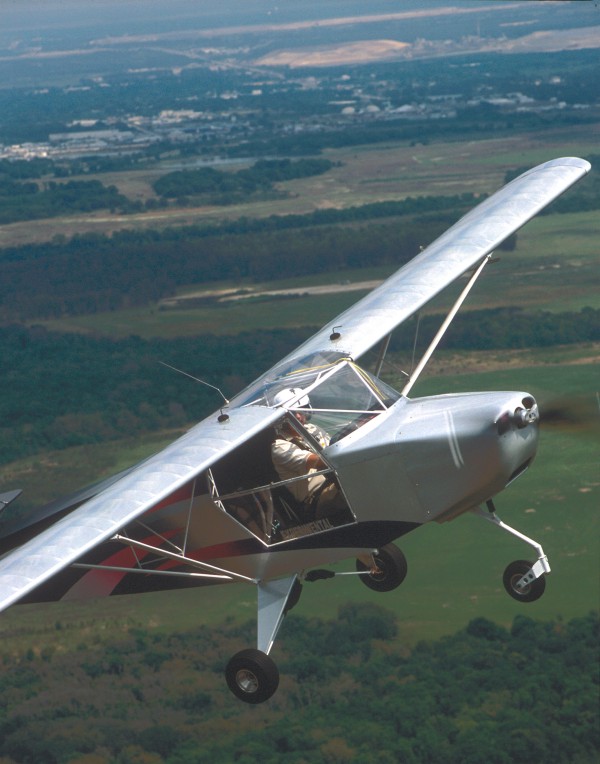
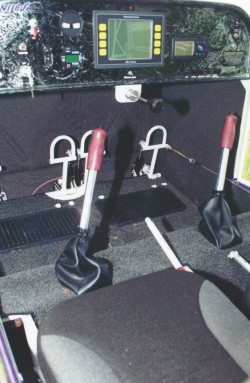
FULL DUAL – The Escapade should make an excellent training aircraft. Not only is the nosewheel best for students, but both seats enjoy full controls and the same access to flaps and throttle. Hydraulic toe brakes (optional) are fitted to each set of rudder pedals.
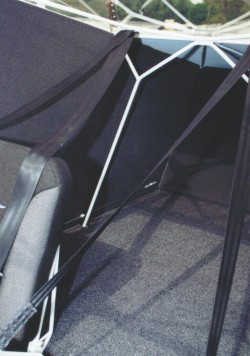
CAMPING OUT – Just Aircraft says you can remove or fold the seats and use the spacious cabin as a place to spend the night. You’ll have to watch weight and balance in the air, but no one will overlook the Escapade’s large interior volume.
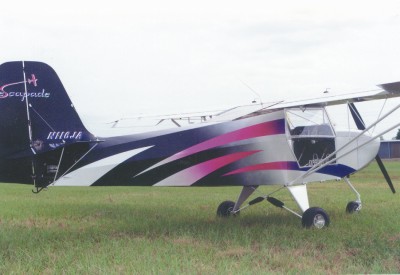
N-NUMBERED – Because of its speed and weight with the 81-hp Rotax 912 engine, the Escapade requires FAA registration and inspection. However, the Escapade has retained the ultralight qualities of its ancestry.
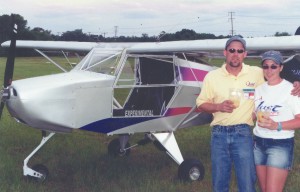
DYNAMIC DUO – Troy Woodland and Kathi Jo Zehr pose by their creation. The two are principals at Just Aircraft though both bring backgrounds from other companies selling this type of aircraft.

DASHING PAINT – Just Aircraft decorated their prototype Escapade to attract attention and it does. The new side-by-side 2-seater replaces the company’s older, tandem Summit model.

TWO-TONED – The interior of the prototype Escapade was cleanly finished in a two-tone gray with these comfortable seats embroidered with the company’s sweeping logo.

FLIGHT DECK – The Stratomaster from MGL Avionics is a slick instrument that presents analog readings from a digital source. You can check altitude, speed, or revolutions with a glance (not having to read a number). Much more information is presented below in both graphic and numerical form. This particular display was imaging erratically on the left and right edges. Button controls on each side were quite intuitive.

DISCREET AILERONS – The older Kitfox models used flaperons. While they worked well and offered light handling, their low speed control range was limited when deployed. The Escapade avoids that problem with separate controls for flaps and ailerons.

QUICK FOLD – The Escapade retains the famous quick-folding Kitfox-style wing but they take it beyond the older models. You remove the turtle deck plastic, pull a pin at each wing/fuselage junction, and fold the wings aft without disconnecting any controls. This helps assure you reassemble the wings correctly and they remain supported by the struts.

BOTH WAYS – I flew the tri-gear Escapade and that’s the way most pilots may want it. But Just Aircraft swapped the nosewheel for a tailwheel during Sun ‘n Fun ’03 and flew again in a short time. Note the fittings are already in position for you to start to make this change with the mains.
Engineering design is usually an evolutionary process. While occasionally a breakthrough idea comes to market, most development in aviation is a result of small steps. The Escapade is a good example.
Once Flying K Enterprises (now Sky Raider LLC) offered their Sky Raider. The single-seater had much in common with the immensely popular SkyStar Aircraft Kitfox. In fact, when SkyStar offered their Kitfox Lite single-seater, Flying K built the welded fuselage for them.
Then came the Sky Raider II with a tight back seat that could be used for an occasional ride though not instruction as no controls were installed in the rear. The new Summit offered by Just Aircraft late last year was a variation on the Sky Raider II theme.
Company leadership changes as do their designs and the path from Flying K to Just Aircraft is convoluted; other business names are involved. By example, Rocky Mountain Wings, run by former Flying K partner Stace Schrader, offers their very similar Ridge Runner.
Considering similar-appearing models from SkyStar, Flying K, Rocky Mountain Wings and Just Aircraft, buyers could be excused if they had trouble correctly identifying the players. Fortunately, everyone knows the basic shape of the plane.
All-New Just Aircraft
Now the waters clear somewhat and the resultant Escapade is something similar to SkyStar’s Kitfox Lite Squared, a side-by-side 2-seater, which followed that company’s Kitfox Lite single-seater. However, in a recent announcement, SkyStar says it has discontinued production of the Light Squared (see “Flightlines,” this issue).
So, Just Aircraft can now manufacture their Escapade without (at present) any head-on competitor for this type of aircraft. The new machine proved to be an interesting plane visited enthusiastically by potential customers as the flying season opened in central Florida last April.
Speculation about the Escapade being merely a reengineered version of the older Sky Raider II – or Just Aircraft’s own similar-looking Summit – is wrong despite the common personnel in the history of each design. The Sky Raider II squeezes a second occupant into the baggage space aft of the pilot, something like New Kolb does with their FireStar II. But with the Escapade, Just Aircraft changed this design to a side-by-side 2-seater improving the configuration for anyone who wants to instruct, or other pilots who want to see their passenger’s joy at going aloft.
When reinventing the Escapade, some design attributes stayed the same, and some changed. Let’s review the basic list.
Both the Sky Raider II and the Escapade use welded 4130 chromoly steel fuselages. Both feature wings that fold in less than 2 minutes. On the Escapade, Just Aircraft says no disconnecting of controls or surfaces is necessary, which should increase the speed of the wing-fold operation and reduce the chance of improper reassembly.
The Escapade can be either taildragger or tricycle landing gear configured. The factory says it is an easy swap.
The Escapade uses the famous Kitfox wing construction and gains from its fluid handling, though I felt the Escapade was somewhat better behaved than the Kitfox, at least when measured by my ability to keep the slip indicator’s ball centered.
The Escapade has full dual controls with center sticks available at each seat. The cabin is 44 inches wide, which allows for adequate room for two average-to-large occupants. Windows curve outwards to improve elbowroom.
The Escapade has been engineered, the factory says, for engines ranging from the 50-hp Rotax 503 to the 120-hp Jabiru 3300. I did not examine any engineering documents or test results to verify that the structure can accommodate such a wide power range, but prior experience suggests this type of design could indeed use the Rotax 503 – though 50 hp might be too low for some loading or departures from high elevations.
Many pilots will be pleased to hear that Just Aircraft’s British partner Reality Aircraft has helped the Idaho company work on Section S certification (for ultralight-like aircraft). I know the British certification system to be a robust program and meeting it fully is no small accomplishment that proves the reliability of the design. Perhaps also part of this British government approval, Just Aircraft says the individual seats were tested to 264 pounds. Both seats are adjustable even while occupied and the spacious cabin gives plenty of leg- and headroom.
I found the visibility quite wonderful to the sides, upward, and even back somewhat. However, the Escapade did not have particularly good visibility over the nose. This is a prototype machine and some changes, perhaps in the cowling, may be made. Some engine cooling issues may require such a change and Just Aircraft’s Troy Woodland talked about trimming here and there on the cowl to address them.
Classy Environment
Just Aircraft exhibited a strikingly painted aircraft with a finished interior. It looked as good to our cameras as it did to visitors. The entire inside of the Escapade was carpeted. This gave a professional look and also deadened noise a bit.
The flap detent system worked well and flap settings were secure and functional. The throttle is conventionally placed and works as you’d expect with a good friction lock, but no hand rest. Both seats were fitted with toe-actuated hydraulic brakes (a $650 option).
Windows open nicely in flight and they don’t slap the bottom of the wing on opening in the air. The Escapade’s skylight is very nice. My head was comfortably up inside the cockpit with no cramped feeling.
Since our test Escapade was the prototype model, some changes will be made. The upper half of the door will have its own latch so you can open it from the outside and then open the entire door. At present, a locked side cannot be accessed from the outside.
The Escapade’s seats adjust while sitting on them, assuming you maintain lubrication on the slide rails. You pull up on a small T-handle on a center rail to set any one of six settings about 1 inch apart.
Naturally, the nosewheel of the Escapade – versus tailwheel of the Summit and Sky Raider II – makes the Just Aircraft model more desirable to those without tailwheel experience. Since this covers most pilots, the Idaho company is identifying that majority as potential customers. Instructors also prefer tri-gear for their students. But for purists who disdain “nosedraggers,” Just Aircraft has a quick-swap tailwheel conversion. Note: The Escapade I flew was optionally nosewheel configured ($950). The plane comes standard in taildragger configuration.
Light and Responsive
The Kitfox heritage and its offspring established in the Boise, Idaho area have several common themes: basic shape, wing construction, fuselage weldments and handling similarities. To me the latter is one of the strongest shared points.
The Kitfox has long been synonymous with light handling and the Escapade is no different. However, it is noticeably easier in the Escapade to keep the slip indicator’s ball centered right from the start. I suspect the tail is more effective and that the linkage may be set to give somewhat less action for a given amount of control input, i.e., she’s a little less responsive. The combination made for more predictable handling in my opinion. In contrast, my first flight in a Kitfox several years ago saw the ball often out of the center.
As I rolled in to the left in the Escapade, very little rudder was needed to keep the ball centered. Of course, P-factor is at work in this direction; entry to the right took more rudder. Adverse yaw, while still present, appears subdued compared to older Kitfox models. If you avoid overuse of the rudders you should easily keep turns coordinated. Most pilots will quickly adapt to this configuration.
Despite a common history, the Sky Raider II showed a higher degree of adverse yaw. So obviously, Just Aircraft did more than move the second seat alongside the pilot’s seat. The use of a smaller wing might also be part of the improved handling equation. The Escapade has a 28.5-foot wing with 108 square feet of area while the older Summit (similar to the Sky Raider II) has a 32.25-foot span with 121 squares. A longer wing can result in greater adverse yaw, if control surfaces are similar and other attributes are the same.
Even with a smaller wing, the 81-hp Rotax 912 engine hauled us into the air most vigorously. You could save a lot of money (about $5,000) by choosing the 50-hp Rotax 503 and for solo flying this powerplant might provide plenty of power. But lower power combined with the Escapade’s smaller wing suggest higher speeds for takeoff and landing so I bet most buyers will go with larger powerplants.
Woodland says that back in Idaho where the weather is cooler, they were seeing 95-mph cruise at 5,200 rpm. This is with the 81-hp Rotax 912, as I flew the Escapade, but Woodland feels that with a 100-hp Rotax 912S, cruise will increase to about 100 mph.
In Florida’s higher heat and humidity, performance was surely affected. Nonetheless, my experience with indicated speeds (subject to instrument errors) matched the factory claims. One difference: I flew solo as is my preference when doing flight evaluations. Therefore I was well under gross weight.
Even at lighter weights, this prototype-cowled Escapade was running on the hot side. I saw 239° water temperature – just below the 240° Woodland asked me to stay under – but I was able to get it down to 210° by reducing throttle and lowering the nose. During all cruise speed operations, water temperatures stayed in the very low 200s and high 190s, well within the comfort zone. Later, however, Woodland drew an imaginary line on the cowl where he feels he can modify the shape to allow more warm air outflow, which should solve the heating problem, he feels.
Power-off stalls in the Escapade were quite mild with the modest break coming at about 29 to 30 mph, according to the installed ASI. Not only is the speed admirably low (if accurate), the break was milder than I recall from a Kitfox.
The genetic history remains though, with the Escapade dropping the left side regularly on stalls. The more aggravated the stall, the more sudden was that wing drop and a very deep stall can produce a bank that suggests spin entry. Fortunately, more moderate handling won’t get close to this point and the airplane gives you adequate warning that a stall is imminent.
Just For You?
Another legendary Kitfox quality retained on the Escapade is the folding wing system. Easily transportable, the ultralight needs only minimal hangarage: 8.5 feet x 21 feet x 6 feet will suffice, the factory says.
The Escapade does the older Kitfox models one better by incorporating a system that eliminates the need to delink the wing controls during folding. You remove the turtle deck, pull the wing pins and fold the wings back, which remain supported by struts that are not disconnected.
For genuine 2-seat operations – whether for instruction or passengers – side-by-side is a far better configuration than tandem. Most pilots I know prefer to be able to see their passenger or student and tandem seating makes this all but impossible. In addition, your fellow occupant will like the much easier entry. The Escapade’s doors fold all the way forward to the nose cowl so you need only turn around and sit down.
The Escapade is priced without engine and sells at an introductory price of $12,500, with a standard price of $14,500 announced. Just Aircraft sells the 50-hp Rotax 503 and 81-hp Rotax 912 (the latter used on the prototype evaluated here), but their price list seems to promote the Jabiru engines that have proven popular on many kit-built airplanes. For less-aware pilots, the Australian engine company makes two appropriate powerplants. One is the 4-cylinder 2200 model for $8,500, which Just Aircraft says puts out 80 hp. The other is the $11,500 3300 6-cylinder with 120 hp. I can’t imagine any Escapade needing this much power, but knowing pilots, the company will find some buyers for it. I did not get to examine any documentation that suggests the airframe and motor mounts have been tested for this power range; those who want the big Jabiru should inquire further. With the $10,500 81-hp Rotax 912, the Escapade was plenty powerful.
To sum up, I enjoyed my flight in Just Aircraft’s new Escapade. In just about every relevant way, many pilots will regard it as a superior machine.
| Seating | 2, side-by-side |
| Empty weight | 530 pounds |
| Gross weight | 1,232 pounds 1 |
| Wingspan | 28 feet 6 inches |
| Wing area | 108 square feet |
| Wing loading | 11.4 pounds per square foot |
| Length | 19 feet (wings folded) |
| Width | 8 feet (wings folded) |
| Cabin Interior | 42 inches |
| Height | 7 feet 2 inches |
| Fuel Capacity | 19 gallons |
| Kit type | Construction kit with Quick-Build options |
| Build time | 300-450 hours |
| Notes: | 1 Weight listed in anticipation of light-sport aircraft. |
| Standard engine | Rotax 912 (81 hp) |
| Power | 50-120 hp |
| Power loading | 15.4 pounds per hp |
| Cruise speed | 75-95 mph |
| Stall Speed | 32 |
| Never exceed speed | 130 mph |
| Rate of climb at gross | 900 fpm |
| Takeoff distance at gross | 300 feet |
| Landing distance at gross | 300 feet |
| Range (powered) | 400 miles (4.5 hours) |
| Fuel Consumption | 4.0 gph |
| Standard Features | Two side-by-side seats, full enclosure with doors and windows that open separately, skylight, folding wings, push-button flaps, steerable tailwheel, 19-gallon fuel tank, fiberglass used on cowling, instrument panel, wing tips and on leading edges of flaps and ailerons, folding wings, seat harnesses, fabric and glue, large tires, trim, bungee-suspended gear. |
| Options | Powder-coated fuselage weldment, quick-build wings, flaps and ailerons, hydraulic toe brakes, electric trim, tinted Lexan for windows and skylight, lighting kit, interior finish kits, spinner, extra-large tires and wheels, skis, nosewheel conversion kit. |
| Construction | Factory-welded steel fuselage, wood wing ribs, fiberglass fairing, dope-and-fabric wing coverings. Made in the USA. |
Design
Cosmetic appearance, structural integrity, achievement of design goals, effectiveness of aerodynamics, ergonomics.
Pros – Side-by-side Escapade useful for training or, if N-numbered, passengers. Laden with features many buyers want. Proven configuration and construction with good handling and performance. Welded steel structure and folding wings.
Cons – Too heavy, as tested, to qualify for Part 103 training exemption. New competitor in a field of several that look similar (though the Escapade isn’t identical to others). With fiberglass airplanes coming from Europe, some may feel the design looks dated.
Systems
Subsystems available to pilot such as: Flaps; Fuel sources; Electric start; In-air restart; Brakes; Engine controls; Navigations; Radio; (items covered may be optional).
Pros – The Escapade as tested was well-equipped, featuring electric starting, 3-notch button-detent flap handle, directional toe brakes, and dual center sticks. Trim knob located between seats at base of flap handle. Panel-mounted primer. Plenty of panel room for radios or extra gauges.
Cons – Big 19-gallon fuel capacity not permitted for Part 103 trainers. Four-stroke engine may produce higher maintenance bills (though less frequently). Fueling is on top of wing; get a ladder. No other negatives.
Cockpit/Cabin
Instrumentation; Ergonomics of controls; Creature comforts; (items covered may be optional).
Pros – Earlier Summit model was a tight tandem fit; the Escapade is a roomy side-by-side with outward curved windows. Seats adjust fore and aft even while occupied (if kept lubricated). Entry to either seat is simple; much better than earlier tandem model. Nicely finished interior; good cargo area. Doors-open flight works well; windows float upward and stay put.
Cons – Clear doors and windows may not reassure those who like structure surrounding them. Throttle offers no arm/wrist rest. A couple of wide or big fellows may feel cramped in the Escapade. Prototype’s door/window latches need improvement to allow access (work is already planned).
Ground Handling
Taxi visibility; Steering; Turn radius; Shock absorption; Stance/Stability; Braking.
Pros – Nosewheel steering is responsive through use of directional toe brakes. Brakes worked quite effectively and are mounted to both sets of rudder pedals. Secure footing with wide stance and good shock absorption with bungee suspension. Generous ground clearance.
Cons – Steering less responsive than full-swiveling tailwheels (though directional brakes and castoring nosewheel help). Visibility over the nose was not as clean as expected for a nosedragger.
Takeoff/Landing
Qualities; Efficiency; Ease; Comparative values.
Pros – Climb is most enthusiastic with 81-hp Rotax 912 engine; solo ground roll was less than 200 feet. Excellent visibility around you at all times and to front during landings. Flaps were quite effective at controlling approach path steepness. Strong aileron response helps in crosswinds.
Cons – Shorter wingspan than earlier Summit tandem model, so ground roll is longer and speeds somewhat higher. Higher weight with larger engine choices. Rotax 912S or Jabiru 4- or 6-cylinder engines mean faster speeds during takeoff and landing (though some may welcome this compromise).
Control
Quality and quantity for: Coordination; Authority; Pressures; Response; and Coupling.
Pros – Noticeably improved handling qualities over others in this design configuration. Light, reasonably fast, authoritative. Controls system displays a good balance between ailerons and rudder. Coordination exercises and precision turns went well from the start.
Cons – What’s good for some pilots may not be for others; the Escapade’s quicker handling may be too fast for some newer pilots. Heavier engine up front (like Rotax 912 or Jabiru 2200/3300) may demand greater use of trim system.
Performance
Climb; Glide; Sink; Cruise/stall/max speeds; Endurance; Range; Maneuverability.
Pros – Fuel consumption plus noise and vibration are good with the Rotax 912 4-stroke engine. As with similar designs, performance is very good for such a small wing (108 square feet). Very strong climb with Rotax 912. Cruise is nearly 100 mph without straining engine.
Cons – Side-by-side suffers extra frontal drag compared to earlier tandem model, the Summit. Sink rate without flaps didn’t impress me (understandable with higher-loaded small wing). Engine tended to run rather hot, requiring management; factory plans changes in the cowling to remedy this.
Stability
Stall recovery and characteristics; Dampening; Spiral stability; Adverse yaw qualities.
Pros – Lower adverse yaw than experienced on other similar designs. Stall speeds were admirably slow for small-area wing; down close to 30 mph when solo. Stalls broke cleanly. Longitudinal power response was positive (though a bit slow). Four-point belts for both seats.
Cons – Stall break may be sudden for pilots with less experience. Disturb the joystick at trim and the Escapade returns to level somewhat slowly. Stick range seemed less generous than some prefer, noticed most in steep turn maneuvers with only cruise power.
Overall
Addresses the questions: “Will a buyer get what he/she expects to buy, and did the designer/builder achieve the chosen goal?”
Pros – The Escapade is what a lot of pilots are seeking; Kitfox-like looks, performance, and handling without a higher price and complexity. Options can quicken your building and personalize your Escapade. Folding wings do not require control disconnect (possibly saving improper reassembly).
Cons – Base price of $14,500 (after intro $12,500 offer) is higher than some alternatives; costly 4-stroke engine not included. Painting and finishing can add significantly to price – especially if you want your plane to look like the factory Escapade.


Where can I find this aircraft or kit? Thank you very much.
Hi Arthur: Please contact Just Aircraft directly to see how they might help you.
Where can you get information on this plane to buy it? What website has the information?
HI again, Arthur: Same answer as your other question: Just Aircraft
Hi, do your doors leak a lot of air during flight, also do they hinge from top and open up?
As Escapade is a kit, you can build it the way you want, including door seals. I advise you contact the factory or Escape users for more info.